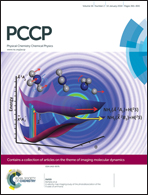Velocity map imaging of ion–molecule reactions
Abstract
Velocity map imaging has been a highly successful method to study molecular and chemical dynamics. In recent years, we have combined this method with ion–molecule reactive scattering experiments and studied the dynamics of several fundamental ion–molecule reactions. Here, we describe the main components of the experiment and discuss the most important limitations to the obtainable imaging resolution. Then, results from our group are presented for both cation and anion–molecule reactions. Specifically, the charge transfer reaction Ar+ + N2 and the nucleophilic substitution reaction X− + CH3I (X = Cl, F, OH), including recent results on micro-solvated water cluster anions, are reviewed. Furthermore, new and open questions and several future directions for research on ion–molecule reactive scattering are mapped out.

- This article is part of the themed collection: Imaging molecular dynamics

 Please wait while we load your content...
Please wait while we load your content...